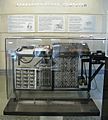Instruction level parallelism facts for kids
Instruction-level parallelism (ILP) is a smart way computers make programs run faster. It's about how many steps, or "instructions," in a computer program can be done at the same time. Think of it like a team working on a project: if some tasks don't depend on each other, they can be done by different people at the same time.
For example, imagine these steps in a program:
- Step 1: Calculate A + B to get E
- Step 2: Calculate C + D to get F
- Step 3: Calculate E * F to get G
Steps 1 and 2 don't need each other, so a computer can do them both at the same time. But Step 3 needs the results from both E and F. So, Step 3 has to wait until Steps 1 and 2 are finished. If each step takes one unit of time, the computer can finish all three steps in just two units of time instead of three. This is because Steps 1 and 2 happen together.
Computer designers and compilers (which translate code into what the computer understands) try to use as much ILP as possible. Normally, programs run instructions one after another. But ILP lets the computer overlap instructions or even change their order to get things done faster. The amount of ILP possible depends on the type of program. For example, graphics programs often have lots of ILP, while cryptography programs have less.
Contents
How Computers Use ILP
Computers use several cool techniques to achieve instruction-level parallelism. These methods help the processor work on multiple instructions at once, making your games and apps run smoothly.
Instruction Pipelining
Imagine an assembly line in a factory. With instruction pipelining, a computer breaks down each instruction into smaller steps. While one instruction is in its first step, another instruction can be in its second step, and so on. This way, multiple instructions are being worked on at the same time, even if they are in different stages of completion. It's like having several cars on a car wash line, each at a different stage of washing.
Superscalar Execution
A superscalar processor is like a computer that has multiple "workers" or execution units. Instead of just one worker doing one instruction at a time, a superscalar processor can have several workers doing multiple instructions at the same time. This means it can complete more than one instruction in a single clock cycle.
Out-of-Order Execution
Normally, a computer follows instructions in the exact order they are written. But with out-of-order execution, the computer can be smart. If an instruction is waiting for something (like the result of an earlier calculation), the computer can go ahead and start working on other instructions that are ready. It will only make sure that the final results are correct, even if the instructions weren't done in the original order. Remember our example where 'g' had to wait for 'e' and 'f'? The computer makes sure those dependencies are met.
Register Renaming
Computers use special storage spots called "registers" to hold data they are working on. Sometimes, different parts of a program might want to use the same register, which could slow things down. Register renaming is a trick where the computer gives these instructions different "renamed" registers. This avoids unnecessary waiting and allows more instructions to run out of order.
Speculative Execution
Speculative execution is like a computer guessing what it might need to do next. Sometimes, a program has a "branch," meaning it could go one way or another depending on a condition. The computer might guess which way it will go and start working on those instructions ahead of time. If its guess is right, it saves time! If it's wrong, it just throws away the work and starts on the correct path.
Branch Prediction
Branch prediction helps speculative execution work better. It's a technique where the computer tries to predict which path a program will take at a "branch point." By making a good guess, the computer can start working on instructions for that path sooner, avoiding delays.
Why ILP is Important
In the past, ILP techniques were very important for making computers faster. Processors became much quicker than the computer's memory. This meant the processor often had to wait for data to arrive from memory. ILP helped keep the processor busy by working on other tasks while waiting.
However, as computers have gotten even more powerful, the focus has shifted. Now, instead of just relying on ILP, computer designers are also using other methods to speed things up. These include multiprocessing (using many processors together) and multithreading (running multiple parts of a program at the same time on one processor). These techniques allow for even higher levels of parallelism.
Images for kids
-
Atanasoff–Berry computer, one of the earliest computers that explored parallel processing ideas.


